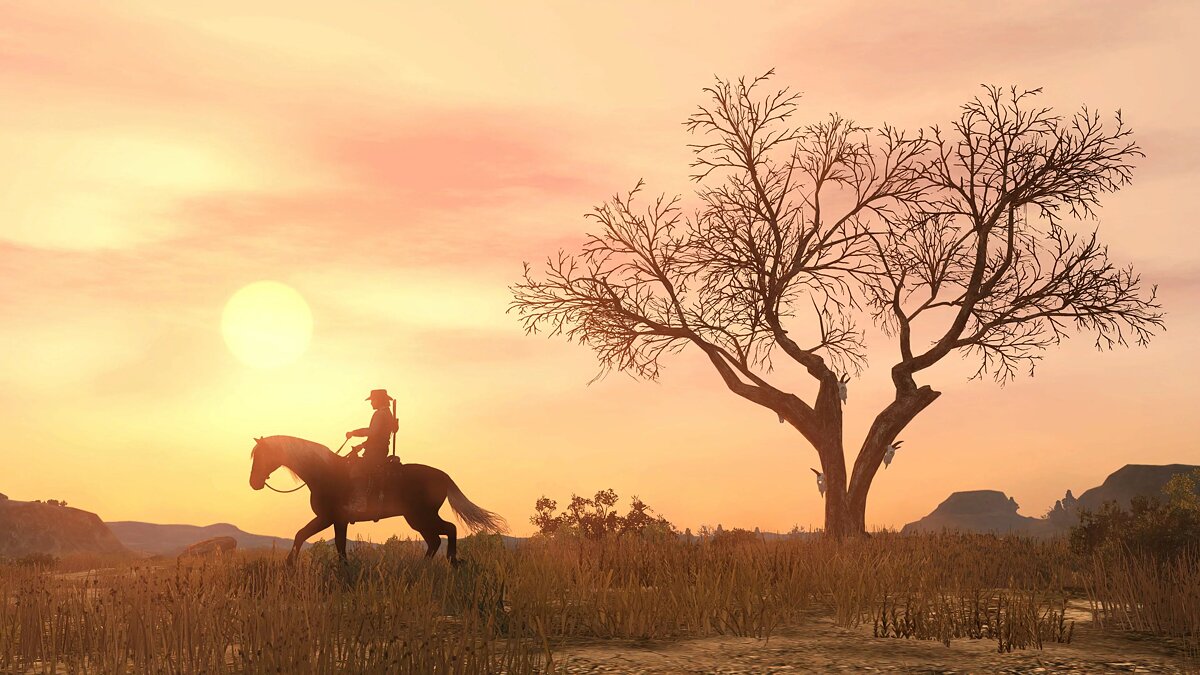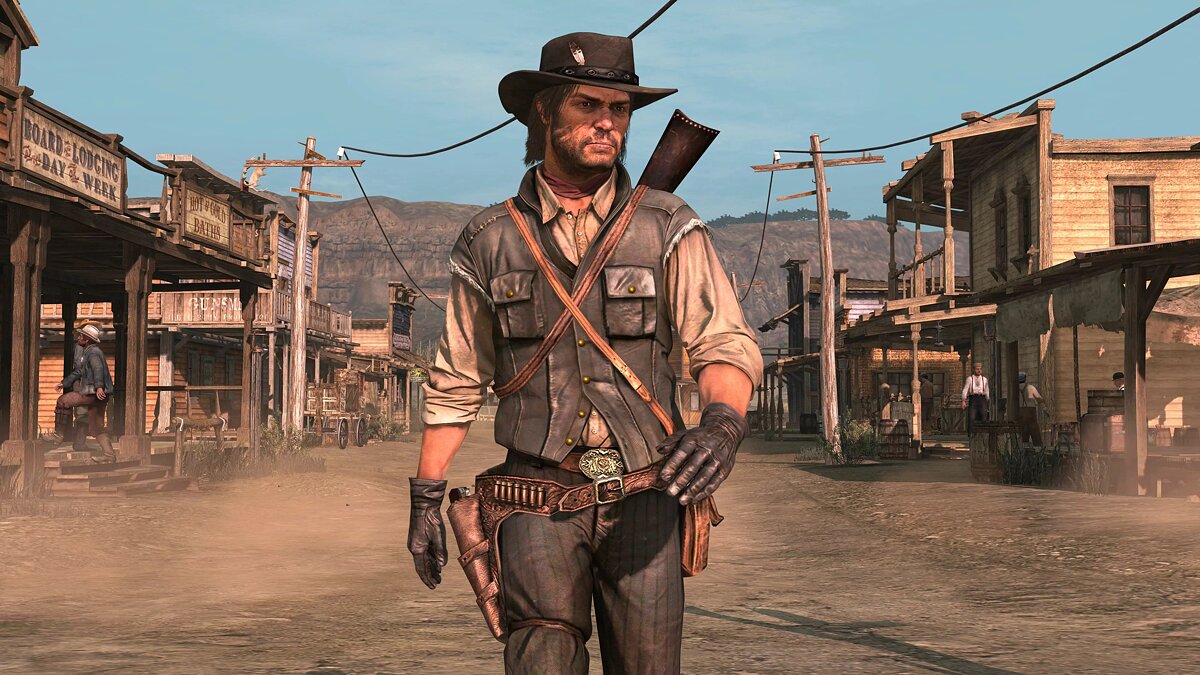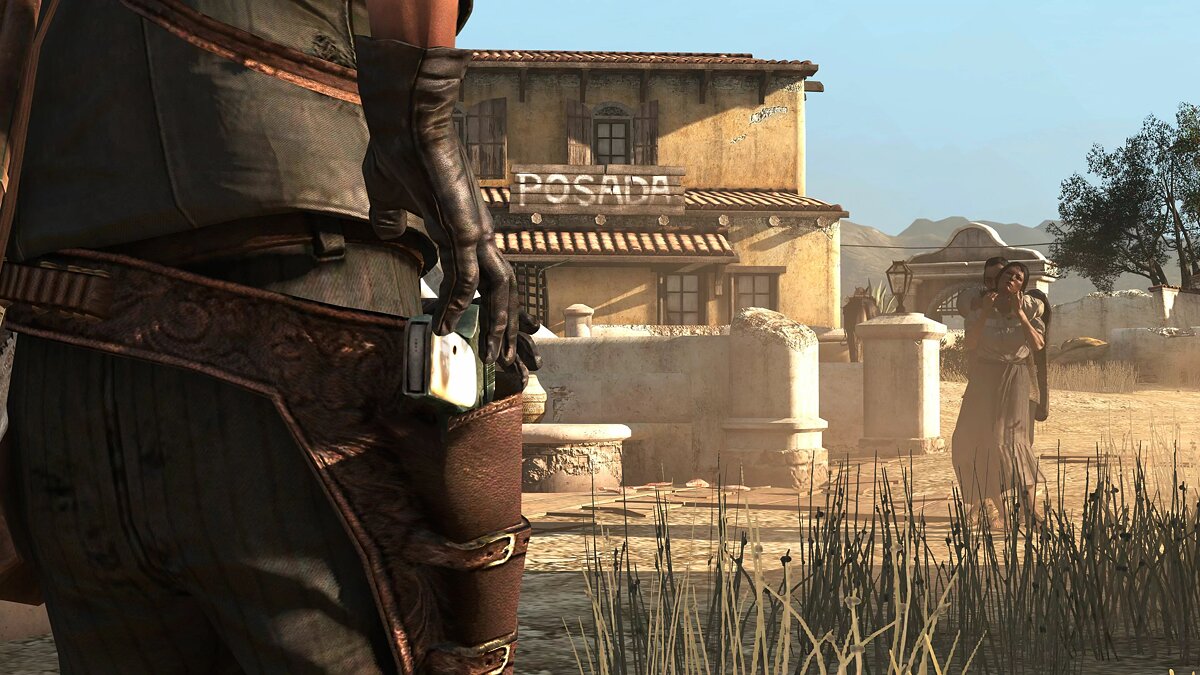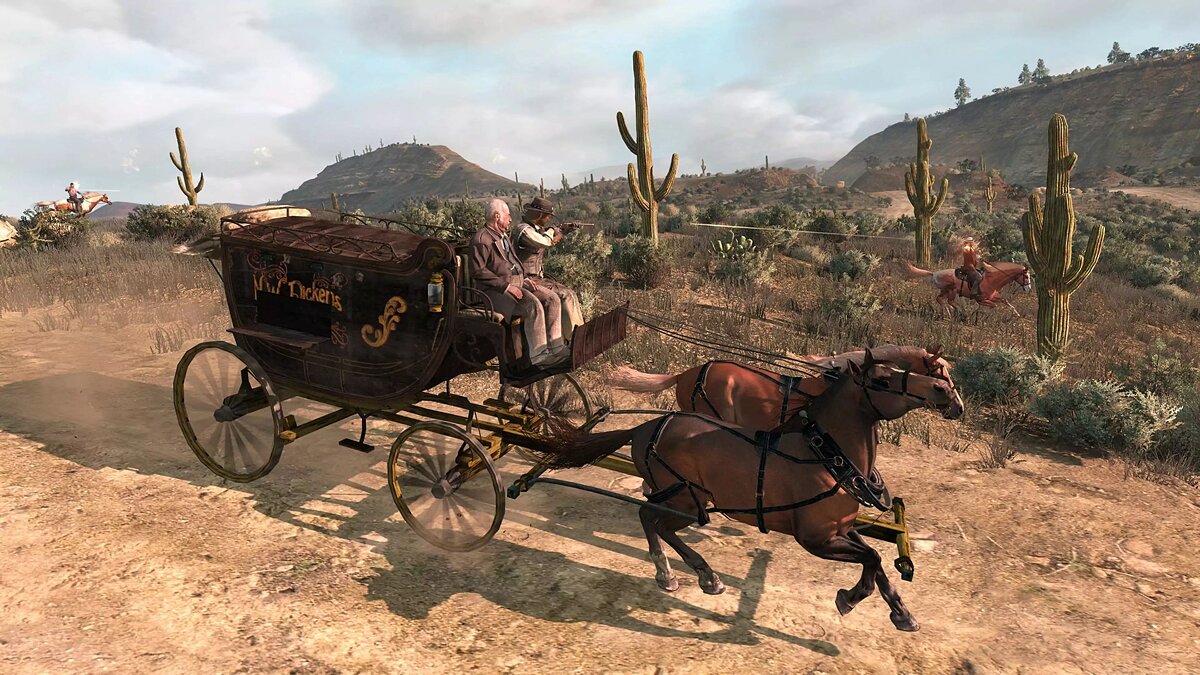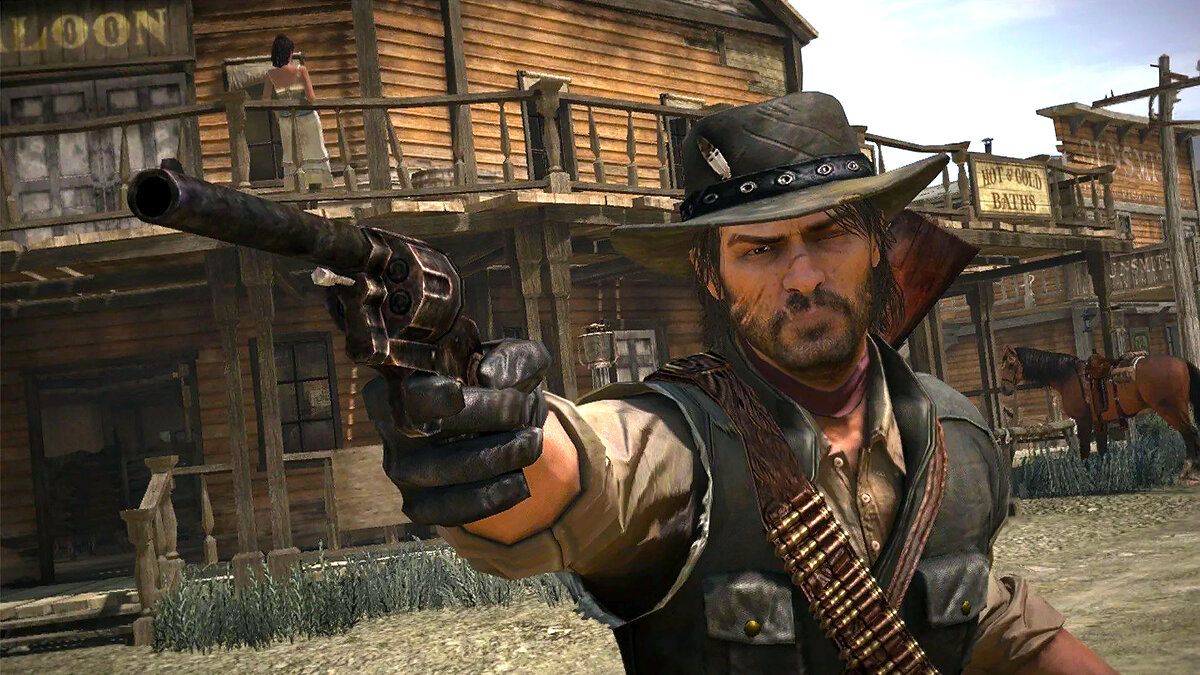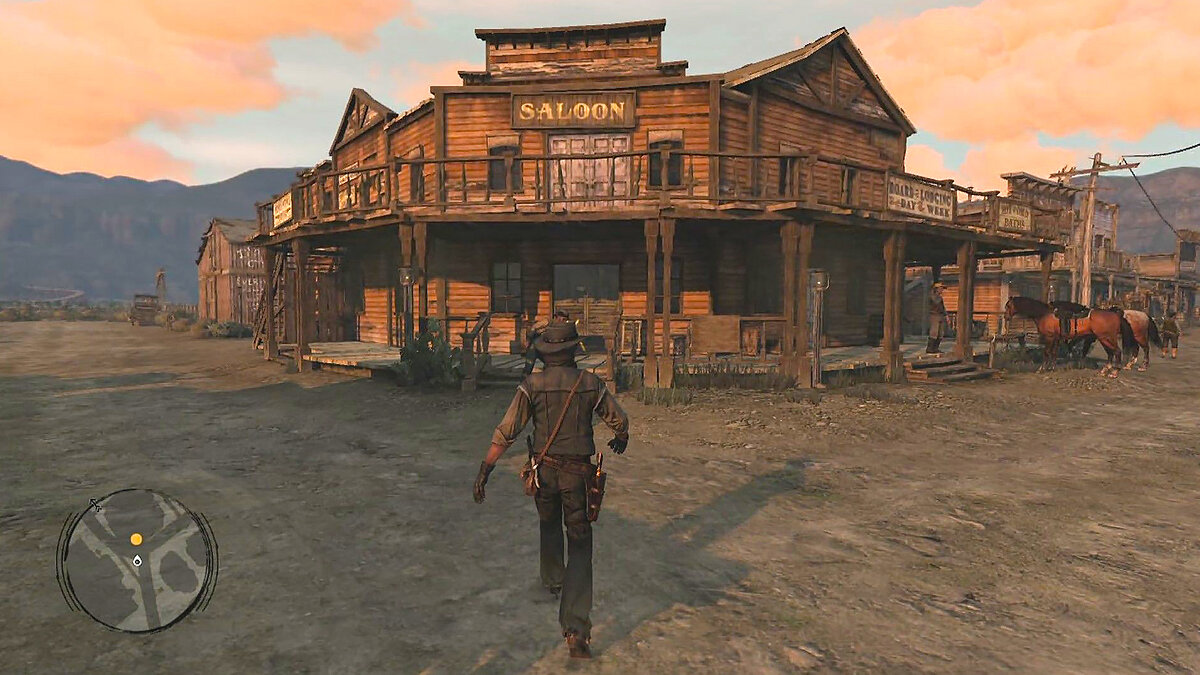Red Dead Redemption (RDR)
Red Dead Redemption, a third-person action-adventure Western game, is one of Rockstar’s most iconic titles. Even a decade later, it still captivates with its deep and emotionally charged storyline, immersing the player in the harsh era of the Wild West. It offers dynamic and varied action set against a cowboy backdrop, along with a vast open world filled with different landscapes, towns, wildlife, and vibrant characters. In 2024, players finally received a PC port, breathing new life into this legendary game and opening it up to a new audience.
The Game World
In the mass culture of the noughties, the Wild West representation was reduced to saloons with drunk cowboys, can-can dancing starlets, and endless revolver duels. R* shattered these stereotypes, recreating with high historical accuracy the atmosphere at the turn of the 19th and 20th centuries Wild West, laying the foundation for the success of Redemption.
The setting was created through characteristic and diverse landscapes, including plains and prairies, deserts and mesas, farmlands, mountains, and canyons. The open world encompasses three fictional regions: American states of New Austin and West Elizabeth, and Mexican state of Nuevo Paraiso. The dynamic change of weather and day-night cycle added further realism to the experience.
The right atmosphere was conveyed through appropriate set design, the look of towns and settlements, streets and buildings. The same attention to detail was applied to interiors, available technology and weaponry, the appearance and clothing of the characters, and their manners of communication and behavior.
Setting a serious tone of the narrative and reflecting the cruelty of the era without embellishment in the prologue, the creators quickly immersed the players in the tough life of the Wild West. Realistic NPC behavior, including the potential for NPCs to react accordingly, further broke the mold. The immersion into the world of Redemption was enhanced by the soundtrack and unique sound design.
The Plot and Characters
John Marston, the protagonist of RDR, settled down on Beecher's Hope farm with his beloved wife, Abigail, and their son, Jack, after a turbulent past with Dutch Van der Linde's gang (featured in RDR 2). However, after an unfortunate encounter with former associate Bill Williamson, John finds himself in the hands of the government. Recognized and cornered, he strikes a deal.
John undertakes to catch the remaining members of his former gang, including Dutch himself. Until then, his family remains in the hands of an uncompromising federal agent, Edgar Ross. Then the player embarks on a journey of 57 unique story missions, numerous unusual situations, and encounters with colorful characters.
The storyline is full of drama, unexpected twists, and complex moral dilemmas. The dialogues are diverse and often serve to develop characters and unravel the plot. However, Redemption offers a more intricate narrative than typical blockbusters, allowing players to see the whole story:
- John is a typical Wild West outlaw but possesses a code of honor. The writers gave Marston personal struggles that the player can explore through John's inner thoughts and comments.
- Part of the story delves into Marston's relationships with his family, and his aspiration to create a better life for Abigail and Jack plays a central role in the plot.
- In his pursuit, John constantly interacts with other characters, gets engaged in various troubles, and is forced between the sides.
- A separate plot line is devoted to Marston's past and his interactions with the Dutch gang. A criminal world, like the feds, attempts to coerce him into certain actions in exchange for his family's safety. Relationships fluctuate from friendly to hostile, influencing the course of the story.
Throughout the game, the writers actively employ "gray morality", avoiding the typical division of characters into good and bad but not eliminating these archetypes. On a broader scale, Red Dead Redemption's plot showcases the changing era and the end of the Wild West as a cultural phenomenon.
For example Edgar Ross: he may seem like a villain, forcing John to risk his life by threatening his family. However, his motivations and goals can be regarded as a necessary evil, and the pressure on Marston is just one episode in the restoration of the Law, a force meant to bring order to the Wild West.
World Map
The map of Red Dead Redemption shows a vast open world with several large regions. Each region has unique natural conditions, climate, and landscape, creating a sense of realistic environmental diversity. Players can explore the map freely, though some locations are initially inaccessible and unlocked as the story progresses.
The size of the world encourages exploration: every journey becomes an adventure, requiring both time and careful route planning due to state borders and rivers crossing the map. Players will discover villages, large cities, Native American settlements, secret bandit camps, farms and ranches, as well as abandoned mines and forts, all of which, combined with the landscape features, create a unique world.
Players can travel on foot, on horseback, or by using various modes of transport like wagons. Fast travel is limited, motivating players to explore the world at a slower pace and notice its details. Random encounters, such as bandit attacks or requests for help from passersby, bring life to every journey. Additional activities include bounty hunting, quest exploration, and item collecting.
Single-player
Red Dead Redemption's walkthrough focuses on exploring a vast and diverse open world. Consequently, no task in the game is complete without extended journeys. To unlock the fast travel, the protagonist must first visit a location. Over time, it will be possible to travel by horse or train.
Aside from the main quests, Redemption offers numerous side missions and events that encourage exploration. While these tasks are often reduced to "find-rob-deliver," they are woven seamlessly into the narrative as characters encountered along the way share their troubles and family histories, making activities feel more immerse.
Moreover, the game world is filled with random events such as rescuing people, robbing trains and stagecoaches, and battles with wildlife. R* also introduced mechanics for hunting, fishing, and resource gathering (herbs, flowers, mushrooms, and other plants). By hunting animals for meat, skinning them, and collecting bones, players accumulate resources and later use them to create potions, sell in stores, or exchange for valuables.
Gameplay Details
RDR had significantly updated the shootouts mechanic. Shooting had been divided into aiming and blind firing. Players could use the environment as cover. The RDR engine calculates hits to specific body parts, resulting in visually noticeable wounds. For instance, if an enemy got shot in the knee, they would start limping.
The new Dead Eye system allowed players to slow down time and mark multiple enemies or objects, and after activation, the protagonist shot them very quickly. Due to improvements over time, the player became even more deadly and gained new abilities within Dead Eye. The system also worked in story moments, enabling cinematic gunfights and making players feel like true Wild West heroes.
Weapons in Redemption could be purchased, found in the game world, or earned as rewards for completing tasks and missions. Besides a variety of firearms in each category (revolvers, pistols, automatic and lever-action rifles, shotguns, and sniper rifles), players could use knives, blades, and bows with arrows. The bow is especially effective for hunting, while knives or tomahawks could be thrown at enemies.
Each weapon has unique characteristics and provides different opportunities during the combat allowing players to choose their preferred playstyle. But in some missions, choosing the right weapon was crucial for successful completion.
The morality system tracks Marston's actions, both good and bad. Acts of righteousness, like saving innocents or apprehending criminals, increase his Honor, granting discounts in stores and friendly interactions with NPCs. On the other hand, committing open murders, theft, and robbery decreased Honor, causing negative reactions from NPCs and exclusion from certain places.
Online Game Mode
In multiplayer, Rockstar has turned the open world of Redemption into a sandbox:
- In Free Roam, up to 16 players can freely move around the world, perform events from single-player mode, form gangs of up to 8 players, and fight with other gangs;
- "Outlaws To The End" expansion introduced cooperative gameplay, allowing 2-4 players to team up and complete 6 especially challenging missions together.
- Various Competitive Modes: These included deathmatches, horse races, cargo capture, and control point modes, both in player-versus-player (PvP) and team formats.
As of late 2024, the RDR multiplayer is still functional on consoles, though finding matches may be challenging. The PC version does not include any online modes.
Release Dates
- May 4, 2004: Release of Red Dead Revolver, which became a success and laid the foundation for future projects.
- May 18, 2010: Red Dead Redemption goes on sale. The game is considered a spiritual successor to Red Dead Revolver, despite not having a direct connection.
- October 26, 2018: The second installment, Red Dead Redemption 2, reveals the backstory of the first game.
- August 17, 2023: Take-Two releases remaster — an updated version of RDR for PS4 and Xbox One.
- October 29, 2024: The release of the updated Red Dead Redemption for PC.
Development and release on PC
The internet was rife with rumors and speculations about the release of Red Dead Redemption on PC for many years. Despite the release of Max Payne 3, GTA 5, and RDR 2, Rockstar never officially handled the PC version themselves, eventually outsourcing the development to Double Eleven. The studio had initially released a remaster of RDR for PlayStation 4 and Switch in 2023, which was known to use the same engine as the original with some added graphical enhancements.
In October 2024, Rockstar unexpectedly announced and almost immediately released the PC port. This version includes the original game, the Undead Nightmare zombie expansion, and bonus content from the Game of the Year Edition. A significant advantage of the port is the inclusion of full Russian subtitles.
Players were thrilled with the announcement — many had waited 14 years to play the iconic console game, which had become a classic. When the news spread, PC gamers began making plans to explore the Wild West on their high-performance machines — the port turned out to be more demanding than RDR 2. Still, there was disappointment among fans who had hoped for a total remake using the engine from the second game. Instead, the remastered port was more modest in scope.
PC Version Features
- Noticeably improved quality of most textures, avoiding the notorious "blurry" visuals, though the level of detail still feels insufficient. Models and objects have seen only minor visual improvements.
- The lighting system has been updated, making the interplay of light and shadows more natural. The quality of the shadows has noticeably improved.
- A new option allows users to adjust the quality of shadows and the draw distance, making the game adaptable to lower-end hardware.
- The animation system is optimized for stable performance at high frame rates, and the voice acting has received additional refinement.
- Full support for modern ultra-wide displays with aspect ratios of 21:9 (Ultrawide) and 32:9 (Super Ultrawide) and resolutions up to 4K. With capable hardware, players can enjoy smooth and responsive gameplay at frame rates reaching 144 FPS.
- HDR10 monitor owners can enable the corresponding option for brighter and more contrasting visuals.
- DLSS 3.7 from NVIDIA and FSR 3.0 from AMD are supported, enhancing image quality through frame generation technology and providing smoother performance across a wide range of PC configurations.
- Naturally, the PC version supports mouse and keyboard controls for navigating the game and controlling characters.
System requirements
Minimum:
- Operating system: Windows 10 (64-bit);
- Processor: Intel Core i5-4670 or AMD FX-9590 @3.5 GHz;
- RAM: 8GB RAM;
- Video card: NVIDIA GeForce GTX 960 or AMD Radeon R7 360 with 3 GB RAM;
- Disk capacity: 12GB HDD.
Recommended:
- Operating system: Windows 10 (64-bit);
- Processor: Intel Core i5-4670K or AMD FX-9590 @4 GHz;
- RAM: 8GB RAM;
- Video card: NVIDIA GeForce GTX 770 or AMD Radeon R9 280 with 4 GB RAM;
- Disk capacity: 12 GB SSD (recommended, but not required).
Connection to GTA and Other Rockstar Games
While the two iconic Rockstar sagas, RDR and GTA, are not directly connected in a shared universe, the studio's attention to detail has led to references and Easter eggs between the games:
- Fan theory says that there might be descendants of RDR NPCs in the modern-day criminal GTA saga. They suggest that Michael, Franklin, and Trevor from GTA 5 could be descendants of John Marston, but a century separates them across different social strata.
- In GTA 5, an inquisitive find is a book on Franklin's bookshelf attributed to J. Marston. It can be either the protagonist of RDR himself or his son. And one of the minor characters of GTA 5 wears a distinctive red T-shirt with a portrait of Marston.
- In one of the RDR missions, you can hear the phrase "No More Hot Coffee". It is a clear reference to the infamous "Hot Coffee'' mod for GTA: San Andreas.
- Sandy Shores, where Trevor lives in GTA 5, features streets named "Armadillo Avenue" and "Cholla Springs Drive", which refer to locations Armadillo and Cholla Springs in the New Austin region, Red Dead Redemption.
- In RDR, players could listen to NPC campfire stories. In U.S. territory, NPCs might mention Red Harlow, the protagonist of Red Dead Revolver. In Mexico, NPCs could refer to the glorious deeds of Colonel Darren and General Diego, secondary characters from the same game.












